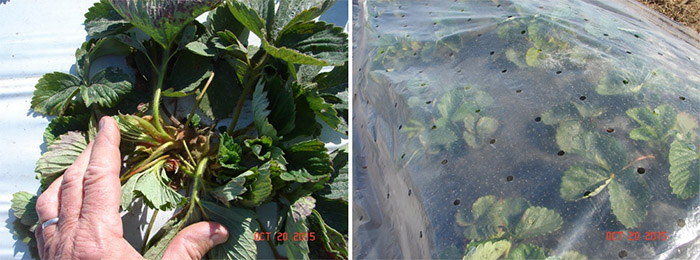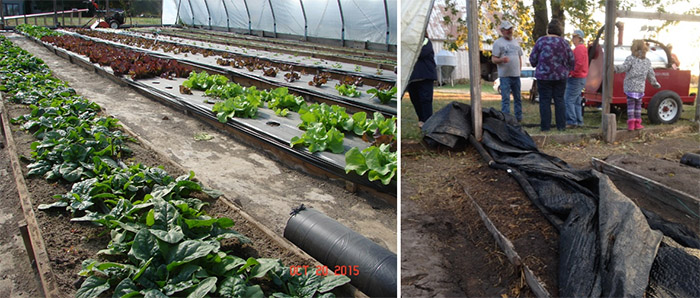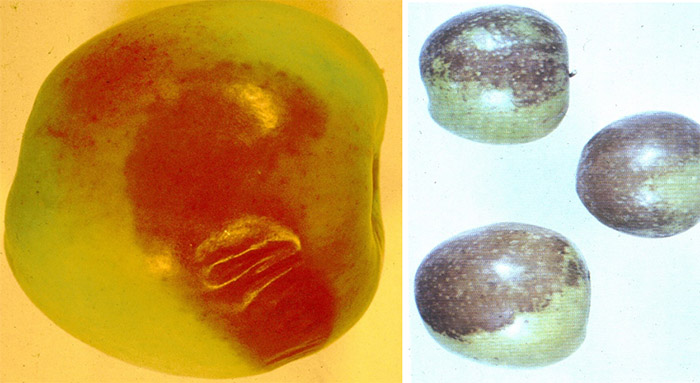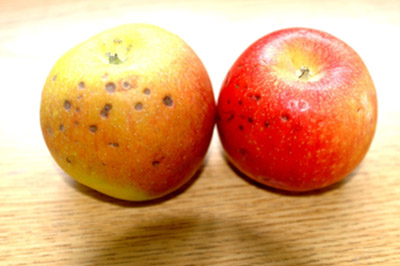"We are what we repeatedly do. Excellence, then, is not an act, but a habit." --Aristotle
Address any questions or comments regarding this newsletter to the individual authors listed after each article or to its editor, Rick Weinzierl, 217-333-6651, weinzier@illinois.edu. To receive e-mail notification of new postings of this newsletter, call or write the same number or address.
In This Issue:
Upcoming Programs (listings for beginning and established growers)
Regional Reports (from southern and western Illinois)
Fruit Production and Pest Management (storing apples for maximum quality)
Upcoming Programs
Check the Illinois SARE calendar for a full list of programs and links for registration.
http://illinoissare.org/ and http://illinoissare.org/calendar.php
Also see the University of Illinois Extension Local Food Systems and Small Farms Team's web site at:
http://web.extension.illinois.edu/smallfarm/ and their calendar of events at http://web.extension.illinois.edu/units/calendar.cfm?UnitID=629.
- Steam Sterilization Demonstration, October 28, 2015. 1:00 p.m. at the farm of Brad Halbrook, Meadowbrook Organic Farm, Shelbyville, IL. Steam has been used for over a century to help reduce insect, weed and disease pests in soil. It can be very effective, especially for high tunnel and organic growers. Jeff Kindhart, senior research specialist at the U of I Dixon Springs Ag Center will lead the demonstration and discussion. For more information and to register, see https://web.extension.illinois.edu/registration/?RegistrationID=13090
- Great Lakes Fruit, Vegetable, and Farm Market EXPO, December 8-10, 2015. Grand Rapids, Michigan. See http://www.glexpo.com/.
- Illiana Vegetable Growers Conference, January 5, 2016. Schererville, Indiana. More details to come.
- Illinois Specialty Crops, Agritourism, ad Organics Conference, January 6-8, 2016. At the Crowne Plaza Hotel and Conference Center, Springfield, IL. More to come in future issues of this newsletter … for now, save the date.
- Also save the dates for several regional programs …
- January 28, 2016: Horseradish Conference at Collinsville, IL
- February 2 and 3, 2016: Tree Fruit Schools at Mt. Vernon and Hardin, IL, respectively
- February 9-10, 2016: Gateway Small Fruit and Vegetable Conference, O'Fallon, IL
- February 25, 2016: Stateline (IL-WI) Fruit and Vegetable Conference, Rockford, IL
Regional Reports
From southern Illinois ... Currently we are in a warm spell with highs this week in the 70s to low 80s for at least a few days. Things are very dry, and it has been over a month since we have had any significant rainfall in Murphysboro. This has been good for pumpkin harvest, but also a struggle for some trying to get fall cover crops to germinate. Both at home at the farm in Monroe County and at Murphysboro we had our first light frost last Sunday morning, October 18, and at the farm I saw 34 degrees around daybreak. This was just enough to take down pumpkin leaves, summer vegetables, and most summer annual weeds. The latest forecast I saw has us back down to more seasonable temperatures by the middle of next week.
For the most part the growing season is about over for most crops. Apple harvest has wrapped up, and as of the frost, if not before, most vegetables are now done for in the field. I do have some fall broccoli planted at home, and it is doing well. It has small heads around 2-3 inches in diameter, and I hope to get a good harvest in a couple of weeks. If you can keep the insects off of it, the taste and flavor of a fall-planted broccoli and other cole crops is excellent. Head formation in the cooler days of October and early November is ideal.
Plasticulture strawberries are off to a good start. The moisture in the summer allowed for adequate soil moisture to pull up beds and we have had lots of warm sunny days that have been ideal for good crown development.
In our demonstration high tunnel at the Jackson County office, we got everything cleaned up from our summer crops and started our fall plantings last week. This also included removing the shade cloth from the tunnel now that temperatures are gradually decreasing. We have planted a carrot variety trial and also a specialty lettuce trial in addition to some assorted greens, radishes and beets. Last year we had a lot of success with our carrots, and we are going to see if we can repeat that success.
Nathan Johanning (618-939-3434; njohann@illinois.edu)
From western Illinois ... Widespread frost on Sunday morning Oct 18th ended the production season for many crops, the exceptions being those crops that enjoy the cooler weather (kale, cole crops, greens, pumpkins, etc.).
Dry soils have really stressed any crops that were not receiving irrigation. After a summer of record rainfall, the past three months have really dried up. My rain gauge recorded 2 inches of rain in August, 1 inch in September, and none thus far in October. Lawns are now dormant and various shades of brown, and cattle producers that aren't grazing corn stalks have been feeding hay for several weeks. Cover crops that have been seeded in the past several weeks are being challenged: spotty or no germination for many of these crops due to the dry conditions. I spread annual rye between rows of plasticulture strawberries over 6 weeks ago and it is still lying ungerminated. However, the tillage radish that was seeded after some sweet corn in mid-August, when soil moisture was abundant, really took off and looks great. A few are blooming and the radish is several inches above ground with 10+ inches below.
We tried some bare-root strawberries planted in mid-July on white plastic at the suggestion of Nate Nourse. The plants are very robust with 3 very large tillers per plant and a LOT of runners to pull off. We wanted to determine if we could get enough branch crown development with these plants compared to plug plants planted the end of August. We also planted strawberry plugs in late August, as we have been doing for a number of years. Our dilemma with this system is the lack of branch crowns and the resulting lower yield. We've never been able to generate the 3-4 branch crowns necessary to allow maximum yields. I believe we are too far north, and the cooler weather has prohibited adequate branch crown development. Andy McNitt suggested using a perforated clear plastic covering to place over the rows in mid-October to generate a little more heat in an attempt to develop branch crowns. We did this on about half of our planting just recently.

Strawberries (from bare-root transplants) on white plastic (left) and under perforated row covers (right).
High tunnel crops escaped the killing frost Sunday morning. The sunny weather of October has really helped any new plantings of greens, etc. really take off. Very few cloudy days and ample sunshine (although only 11 hours of light) has greens in high tunnels looking good.

Greens in high tunnel (left) and steaming demonstration conducted by Jeff Kindhart (right).
Pumpkins are holding up in price in our locale, and demand has been good. Weekends thus far have been sunny, some rather warm, others more fall-like, but no rains mean that visitors to the patch have been numerous.
Asparagus should be allowed to die naturally before any attempt to mow off ferns. The longer the plant photosynthesizes, the more food stored and the larger and healthier the crown. Some prefer to mow the stalks in the fall. If you do this, wait until ferns die off. Waiting until spring will help delay emergence of those first spears (the dead ferns shade the soil) to avoid any late frosts injuring any early-emerged spears.
Those attempting to till the dry soil are finding it extremely hard and compacted. When the heavy rains of June and July fell on saturated soils (which lack oxygen pore space) the result is sealed over, dense soils. Deep tillage can help alleviate this poor soil structure to a certain extent. But in some cases, especially in lower organic matter soils, future rainfall will negate any tillage effects as the particles flow back together over time as moisture percolates through the soil. Freezing and thawing of soil (expansion and contraction) can also help alleviate compaction, but only as deep as the frost travels into the soil. Of course repeated freezing and thawing will be more beneficial. And if the soils stay extremely dry, they won't freeze well.
High tunnel crops continue to mature, although at a much slower pace. Tomatoes, peppers, etc. are still producing. Keep in mind that ventilation of high tunnels becomes important throughout the remainder of the growing season. We are starting to pick spinach seeded in late August in the tunnel. Each year when we use a winter crop in a tunnel we find aphids. Transitioning from summer to winter crops means that there is always something green in the tunnel, allowing aphids to survive. Realize that insect management does not end with the summer crop but must continue throughout the year if winter crops are raised.
Mike Roegge (217-223-8380; roeggem@illinois.edu)
Fruit Production and Pest Management
Storing Apples for Maximum Quality
How can you store apples for up to six months without much loss of quality?
Most apples you see at the grocery stores from December to September have been stored under controlled atmosphere, which consists of keep fruits in a tight room under high carbon dioxide (about 3%) and low oxygen (about 2%). Big commercial storage outfits in Washington, New York, Virginia, and Michigan have huge storage facilities equipped with gas generating units that cost hundreds of thousands of dollars. I am not aware of any controlled atmosphere storage units that meet the needs of the small farmer. But small farmers should not have to compromise the quality of their fruits just because they cannot afford to buy expensive equipment. Here are a few suggestions that should help you keep those apples crisp for a long time.
First, make sure your cold storage temperature can reach as low as 30oF and stay there for a long time (4 to 6 months) without needing major defrost or repair. The closer you maintain the fruit core temperature to 30oF, the longer the fruit will store. What I mean by core temperature is the temperature of the fruit, not the room. There are thermometers that you can buy and insert into the apple to give you an accurate reading. We have kept Goldens and Reds stored at 30oF for up to eight months without much loss in quality. In an unpublished study, we compared apples that were kept in a walk-in cooler set at exactly 30oF for six months to those that were stored at a commercial controlled-atmosphere storage facility. To our surprise, the apples that were stored at regular storage had much better quality than those that were kept in a controlled atmosphere storage facility. (Obviously the CA rooms were not well maintained to commercial standards.) What the data also taught us is that temperature is very critical for apple storage. The closer the fruits are to 30oF, the longer they will keep.
There are only a few varieties that cannot tolerate 30oF. Among them are Honeycrisp, McIntosh-type apples, and a few varieties that tend to have oily skin. These varieties are chilling sensitive, so they should be stored at 36oF instead of 30oF. Some have suggested that Honeycrisp can be stored at as low as 32oF, but the fruits have to be acclimated at cooler temperature (55 to 60oF) for several hours before they are placed in cold storage. The symptoms of chilling injury on these fruit include mealy texture and soft scald. Soft scald is a browning of the fruit skin that looks like someone has rolled the fruit on a hot surface.

Symptoms of soft scald.
Some late-maturing varieties such as Pink Lady, a few Fuji strains, Granny Smith, and Gold Rush, will develop bitter pit after fruits have been in storage for several weeks. Bitter pit is a physiological disorder that happens when the fruits are picked before they have reached full maturity. These varieties are more vulnerable to bitter bit because in Illinois they tend to mature in late October to early November. By that time, farmers are afraid that they will freeze so they pick them before they reach full maturity.

Symptoms of bitter pit.
Humidity control is also important; if the fruit are going to be stored in bins, you can place a tarp or a large plastic bag on the top and sides (not the bottom) of the bin, but do not seal the bag, otherwise the fruit will ferment. The slow respiration from the fruit will generate a controlled atmosphere like environment and that will contribute to keeping the fruits fresh longer. Remember, cold air holds less moisture than warm air so I would recommend that you spray the inside of the cold room with water to keep the humidity high or install a cold mist humidifier. To keep the water in the humidifier from freezing, have it outside the room and pipe the mist into the room.
Mosbah Kushad (217-244-5691; kushad@illinois.edu)
Less Seriously ...
I'm not sure I believe the lead-in to these, but I guess that doesn't really matter ...
A 1st grade teacher presented her students the first half of a well-known proverb and asked them to come up with the remainder of the proverb. Here are some of their words of wisdom.
Don't change horses ... until they stop running.
Strike while the ... bug is close.
It's always darkest before ... Daylight Savings Time.
You can lead a horse to water but ... How?
Don't bite the hand that ... looks dirty.
No news is ... impossible.
A miss is as good as a ... Mr.
You can't teach an old dog ... new Math.
If you lie down with dogs, you'll ... stink in the morning.
Love all, trust ... me.
The pen is mightier than the ... pigs.
An idle mind is ... the best way to relax.
Where there's smoke there's ... pollution.
Happy the bride who ... gets all the presents.
A penny saved is ... not much.
Two's company, three's ... the Musketeers.
Don't put off till tomorrow what ... you put on to go to bed.
Laugh and the whole world laughs with you, cry and ... you have to blow your nose.
Children should be seen and not ... spanked or grounded.
If at first you don't succeed ... get new batteries.
You get out of something only what you ... see in the picture on the box.
A bird in the hand ... is going to poop on you.
Better late than ... pregnant.
University of Illinois Extension Specialists in Fruit and Vegetable Production & Pest Management
Extension Educators – Local Food Systems and Small Farms |
||
Bronwyn Aly, Gallatin, Hamilton, Hardin, Pope, Saline, and White counties |
618-382-2662 |
|
Katie Bell, Franklin, Jackson, Perry, Randolph, & Williamson counties |
618-687-1727 |
|
Sarah Farley, Lake & McHenry counties |
847-223-8627 |
|
Nick Frillman, Woodford, Livingston, & McLean counties |
309-663-8306 |
|
Laurie George, Bond, Clinton, Jefferson, Marion, & Washington counties |
618-548-1446 |
|
Zachary Grant, Cook County | 708-679-6889 | |
Doug Gucker, DeWitt, Macon, and Piatt counties |
217-877-6042 |
|
Erin Harper, Champaign, Ford, Iroquois, and Vermillion counties |
217-333-7672 |
|
Grace Margherio, Jackie Joyner-Kersee Center, St. Clair County |
217-244-3547 |
|
Grant McCarty, Jo Daviess, Stephenson, and Winnebago counties |
815-235-4125 |
|
Katie Parker, Adams, Brown, Hancock, Pike and Schuyler counties |
217-223-8380 |
|
Kathryn Pereira, Cook County |
773-233-2900 |
|
James Theuri, Grundy, Kankakee, and Will counties |
815-933-8337 |
|
Extension Educators – Horticulture |
||
Chris Enroth, Henderson, Knox, McDonough, and Warren counties |
309-837-3939 |
|
Richard Hentschel, DuPage, Kane, and Kendall counties |
630-584-6166 |
|
Andrew Holsinger, Christian, Jersey, Macoupin, & Montgomery counties |
217-532-3941 |
|
Extension Educators - Commercial Agriculture |
||
Elizabeth Wahle, Fruit & Vegetable Production |
618-344-4230 |
|
Nathan Johanning, Madison, Monroe & St. Clair counties |
618-939-3434 |
|
Campus-based Extension Specialists |
||
Kacie Athey, Entomology |
217-244-9916 |
|
Mohammad Babadoost, Plant Pathology |
217-333-1523 |
|